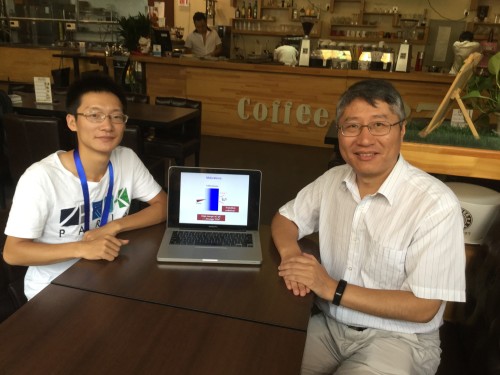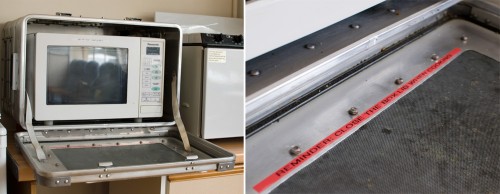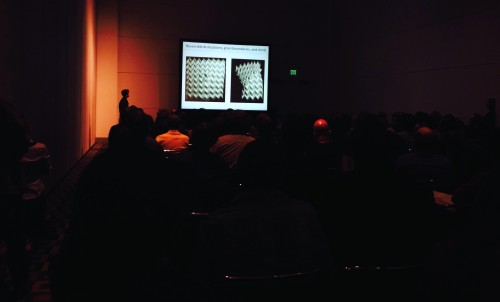Tag archives: graphene
Physics of ski jackets, the eerie sound of thin ice, how figure skaters linger in mid-air
By Michael Banks and Hamish Johnston
Probably with an eye on the Winter Olympics, which starts today, two firms have just released new ranges of high-tech ski jackets. The Swiss technology business Osmotex and the Swiss Federal Laboratories for Materials Science and Technology premiered their new ski jacket at the sport and sportwear international (ISPO) trade fair in Munich. It contains an “electro-osmotic” membrane called HYDRO_BOT in the fabric so that when membrane is switched on with a conventional battery it speeds up the transfer of salt ions across the membrane, taking them away from your sweaty skin. The creators claim it can pump out 10 litres of liquid per square metre per hour. For more details, see the video above.
View all posts by this author | View this author's profile
Churchill discusses aliens, quantum films make the cut, graphene in a dress
By Sarah Tesh
Last September, the Centre for Quantum Technologies at the National University of Singapore invited people to submit short films about quantum physics for their Quantum Shorts 2016 competition. Both scientists and filmmakers alike have made the short list, which has just been released. The films could be about the science, history, theories, technologies or philosophies of quantum mechanics – anything that sparked the imagination. The online competition has been going since 2012 and alternates between short films and flash fiction, and this year the films will be screened at a film festival as well. The shortlist comprises of 10 films, all available to watch and vote for online. There are supernovae, love triangles, muesli with bananas and cats – everything you could want to help explain quantum physics.
View all posts by this author | View this author's profile
Terahertz analytics for better plasmas

Terahertz generators: Gianqian Liao (left) and Yutong Li.
By Hamish Johnston in Beijing
Today was the last day of the Fall Meeting of the Chinese Physical Society here in Beijing and this morning I grabbed a coffee with Yutong Li and Giuqian Liao. I was hoping to learn more about their work that we covered in May in “Coherent terahertz radiation created in laser plasmas“.
Their technique involves firing a powerful laser pulse at a thin metal foil. This creates a plasma in which electrons are accelerated to high energies before bursting out of the foil. When they emerge, coherent terahertz radiation is given off.
View all posts by this author | View this author's profile
Immersive art, physics pumpkins, personalizing Thor’s hammer and more
By Matin Durrani
If you’ve ever been to the Perimeter Institute for Theoretical Physics in Canada, you’ll know that blackboards are everywhere. You can find them in handy little alcoves, in the cafe and even in the institute’s lifts – the idea being that brain-box theorists who have a great idea in their heads can crack off the underlying maths before their thought fizzles into the aether. (Not that there is an aether, of course, but you know what I mean.) Anyway, the institute’s new California-based artist-in-residence Alexa Meade, has taken the idea to a new level, creating a huge 3D living chalkboard to create the “perception-bending art for which she is internationally renowned”. As you can see from the video above, it brings a whole new dimension to the idea of getting “immersed” into science. You can see more images of Meade’s living installation at Perimeter on Flickr.
This week, China’s president, Xi Jinping, is on a state visit to the UK, and today he toured the new National Graphene Institute (NGI) at the University of Manchester. We reported on the planned tour yesterday, with our story including a special behind-the-scenes video that Physics World recorded on our own recent visit to the NGI in the company of its architect and desinger Tony Ling. But an interesting nugget about the Chinese visit has since emerged: it appears that Kostya Novoselov, the Nobel-prize-winning Manchester physicist who helped to isolate graphene for the first time, has presented President Xi “with a gift of traditional Chinese-style artwork, which Kostya himself had painted using graphene paint”. We’ve yet to see what this objet d’art looks like, but I’m sure it’s lovely.
Women in graphene
By James Dacey in Manchester
 Today is the third day of Graphene Week, a conference at the University of Manchester devoted to the fundamental science and applications of 2D materials. While many of the talks require a PhD in materials science to even understand the title (I for one am struggling), one session taking place this evening has the refreshingly simple title: Women in Graphene. Intrigued, I caught up with the session organizer Katarina Boustedt from Chalmers University of Technology in Sweden.
Today is the third day of Graphene Week, a conference at the University of Manchester devoted to the fundamental science and applications of 2D materials. While many of the talks require a PhD in materials science to even understand the title (I for one am struggling), one session taking place this evening has the refreshingly simple title: Women in Graphene. Intrigued, I caught up with the session organizer Katarina Boustedt from Chalmers University of Technology in Sweden.
Graphene Week is an annual event organized by the Graphene Flagship, the EU’s biggest ever research initiative with a budget of €1 billion. As promoting equality is a key part of the Flagship’s mission, Boustedt has launched this initiative to support women working in 2D materials research. Tonight’s two-hour session is designed to start the conversation and find out the types of support that women researchers would like.
View all posts by this author | View this author's profile
Taking a peek inside the UK’s National Graphene Institute

Look, no dust – National Graphene Institute architect Tony Ling showing off the PVC blackboards (Courtesy: Physics World/James Dacey)
By Matin Durrani in Manchester
Do an Internet image search of the word “physicist” and you’ll come across countless pictures of physicists posing in front of blackboards covered with bewildering looking equations. That’s because blackboards are traditionally a common sight in physics labs and research centres – in fact, they’re everywhere at the Perimeter Institute for Theoretical Physics, where my Physics World colleagues Hamish Johnston and Louise Mayor are right now.
But over at the UK’s new £61m National Graphene Insitute (NGI), which I toured earlier today, blackboards are very much verboten. It’s the chalk dust you see, which is a no-no for health-and-safety bosses at the University of Manchester, where the NGI is located. Incidentally, Manchester is also currently home to Andre Geim and Kostya Novoselov, who shared the 2010 Nobel Prize for Physics for isolating graphene for the first time.
View all posts by this author | View this author's profile
Cakes that are out of this world, what’s on Andre Geim’s iPod and who’s the April fool?

The joke’s on me: click on the image for a larger version where you can see the instruction for users
By Hamish Johnston
On Tuesday I was feeling particularly pleased with myself over the April Fool’s piece that I penned. It was about a fictitious microwave-oven ban organized by radio astronomers at the UK’s Jodrell Bank Observatory. But now it looks like I might have a bit of microwaved egg on my face because two of my colleagues visited Jodrell Bank this week and guess what? Astronomers there have built a Faraday cage around the microwave in their tearoom to stop it from interfering with their equipment. Louise Mayor took the above photos: click on the image to read the reminder to microwave users.
View all posts by this author | View this author's profile
Embracing the materials world
By James Dacey
Materials research is enjoying a new golden age. The hit parade of supermaterials that has been discovered in the relatively recent past is extensive. It includes the likes of high-temperature superconductors, quantum dots, bucky-balls, nanotubes, aerogels, silver nanowires and graphene. Meanwhile, new approaches to the commercialization of materials – such as the recent Materials Genome Initiative in the US – are improving the processes by which new materials are transferred from the science lab to practical applications in the real world.
In conjuction with these new discoveries, materials scientists have also made dramatic improvements to the tools they have available for studying and manufacturing materials. Here, the list of advances is seemingly endless. Researchers can now simulate, image and analyse materials with far more accuracy than ever before. Developments in production methods – such as the advent of 3D printing – are also enabling researchers to scale up their new materials with greater ease.
View all posts by this author | View this author's profile
Lights, camera, action at Daresbury Laboratory

Daresbury Laboratory: SuperSTEM is the small, white building right of centre and surrounded by trees. (Courtesy: STFC)
By Hamish Johnston
Recently I was in Liverpool with the Physics World camera crew to film a series of videos, including a feature about the NA62 experiment based at CERN. On the way back to Bristol we spent the afternoon at the Daresbury Laboratory in Cheshire, where we made videos about two major facilities at that lab.
Today, we are premiering the video that we made about Daresbury’s SuperSTEM, which is the UK’s national facility for aberration-corrected scanning transmission electron microscopy (STEM).
View all posts by this author | View this author's profile
